| Image | Common name | Scientific name | Distribution |
|---|
 | Groundscraper thrush | Turdus litsitsirupa | Angola, Botswana, the Democratic Republic of the Congo, Eswatini, Malawi, Mozambique, Namibia, South Africa, Tanzania, Zambia, and Zimbabwe |
 | Ethiopian thrush | Turdus simensis | Ethiopia, Eritrea |
 | Chinese thrush | Turdus mupinensis | China and far northern Vietnam |
 | Song thrush | Turdus philomelos | Europe, North Africa and the Middle East |
 | Mistle thrush | Turdus viscivorus | Europe and temperate Asia |
 | African thrush | Turdus pelios | from Senegal and Gambia in the west to South Sudan, Ethiopia and Eritrea south to north-western Zambia and western Angola |
 | Príncipe thrush | Turdus xanthorhynchus | Príncipe |
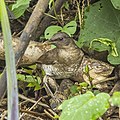 | São Tomé thrush | Turdus olivaceofuscus | São Tomé |
 | Abyssinian thrush | Turdus abyssinicus | Africa from South Sudan south to northern Mozambique |
 | Taita thrush | Turdus helleri | Taita Hills in Kenya |
 | Usambara thrush | Turdus roehli | Tanzania |
 | Olive thrush | Turdus olivaceus | Tanzania and Zimbabwe in the north to the Cape of Good Hope |
 | Kurrichane thrush | Turdus libonyana | Angola, Botswana, Burundi, Democratic Republic of the Congo, Eswatini, Lesotho, Malawi, Mozambique, Namibia, South Africa, Tanzania, Zambia, and Zimbabwe |
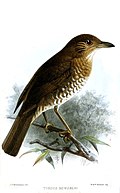 | Comoro thrush | Turdus bewsheri | Comoros Islands |
 | Bare-eyed thrush | Turdus tephronotus | Ethiopia, Kenya, Somalia, and Tanzania |
 | Karoo thrush | Turdus smithi | South Africa, where it is present in Little Namaqualand, the Karoo and Northern Cape, Free State, Gauteng, Limpopo, Mpumalanga and parts of the North West Province |
 | Somali thrush or Somali blackbird | Turdus ludoviciae | Somalia |
 | Chinese blackbird | Turdus mandarinus | south, central and east China |
 | Redwing | Turdus iliacus | Europe and Asia, from Iceland south to northernmost Scotland, and east through Scandinavia, the Baltic States, northern Poland and Belarus, and through most of Russia to about 165°E in Chukotka Autonomous Okrug |
 | Common blackbird | Turdus merula | temperate Eurasia, North Africa, the Canary Islands, and South Asia |
 | Yemen thrush | Turdus menachensis | Middle East |
 | Taiwan thrush [8] | Turdus niveiceps | Taiwan |
 | Grey-winged blackbird | Turdus boulboul | south-eastern Asia from the Himalayas to northern Vietnam |
 | Indian blackbird | Turdus simillimus | India and Sri Lanka |
 | Tickell's thrush | Turdus unicolor | Himalayas, and peninsular India |
 | Black-breasted thrush | Turdus dissimilis | south-western China |
 | Japanese thrush | Turdus cardis | central China and Japan and northern Laos and Vietnam |
 | Grey-backed thrush | Turdus hortulorum | north-eastern China and Russia Far East and winters in southern China and northern Vietnam |
 | Eyebrowed thrush | Turdus obscurus | Siberia south to China and Southeast Asia |
 | Pale thrush | Turdus pallidus | south-east Siberia, north-east China and Korea and may breed in Japan |
 | Grey-sided thrush | Turdus feae | north-east China and migrating to subtropical or tropical moist montane forest in India, and Indochina |
 | Brown-headed thrush | Turdus chrysolaus | Sakhalin, the Kuril Islands, Japan, Ryukyu Islands, Taiwan, Hainan and the northern Philippines |
 | Izu thrush | Turdus celaenops | Izu and Ryukyu Islands of Japan |
| Mindoro island thrush | Turdus mindorensis (split from T. poliocephalus) | montane Mindoro (northwest Philippines) |
 | Luzon island thrush | Turdus thomassoni (split from T. poliocephalus) | montane Luzon (north Philippines) |
| Mindanao island thrush | Turdus nigrorum (split from T. poliocephalus) | montane Negros and Mindanao (Philippines) |
| Wallacean island thrush | Turdus schlegelii (split from T. poliocephalus) | montane Sulawesi and Timor |
| Christmas island thrush | Turdus erythropleurus (split from T. poliocephalus) | Christmas Island |
 | Sundaic island thrush | Turdus javanicus (split from T. poliocephalus) | montane Sumatra, Java and Borneo |
| Moluccan island thrush | Turdus deningeri (split from T. poliocephalus) | montane Taliabu and Seram |
| Papuan island thrush | Turdus papuensis (split from T. poliocephalus) | montane New Guinea and Goodenough Island (D'Entrecasteaux Islands) |
| Bismarck island thrush | Turdus heinrothi (split from T. poliocephalus) | Bismarck Archipelago |
| Bougainville island thrush | Turdus bougainvillei (split from T. poliocephalus) | montane Bougainville Island (north Solomon Islands) |
| Solomons island thrush | Turdus kulambangrae (split from T. poliocephalus) | montane Kolombangara and Guadalcanal (Solomon Islands) |
| Vanikoro island thrush | Turdus vanikorensis (split from T. poliocephalus) | Vanuatu and Utupua |
| White-headed island thrush | Turdus pritzbueri (split from T. poliocephalus) | south Vanuatu |
| New Caledonian island thrush | Turdus xanthopus (split from T. poliocephalus) | New Caledonia and satellites |
| † Tasman Sea island thrush | Turdus poliocephalus | Lord Howe Island and Norfolk Island (east of Australia) (extinct) |
| Samoan island thrush | Turdus samoensis (split from T. poliocephalus) | Savaiʻi and Upolu in Samoa |
 | Fiji island thrush | Turdus ruficeps (split from T. poliocephalus) | Fiji |
 | Tibetan blackbird | Turdus maximus | Himalayas from northern Pakistan to south-eastern Tibet |
 | White-backed thrush | Turdus kessleri | central China |
 | Fieldfare | Turdus pilaris | Norway, Sweden, Finland, Belgium, Eastern France, Germany, Switzerland, Austria, the Czech Republic, Slovakia, Hungary, Poland and Siberia as far east as Transbaikal, the Aldan River, the Tian Shan Mountains in North West China, Anatolia, Israel, Iran and Northwest India, and occasionally north-east India. It is a vagrant to Iceland, Greenland, Spitsbergen, the Canary Islands, the Balearic Islands, Madeira, Corsica, Sardinia, Sicily, Malta and Cyprus. It is a very rare breeder in the British Isles, but winters in large numbers in the United Kingdom, Southern Europe, North Africa and the Middle East. |
 | Ring ouzel | Turdus torquatus | western and central Europe and also in the Caucasus and in the Scandinavian mountains |
 | Black-throated thrush | Turdus atrogularis | east of Europe to Western Siberia and north-west Mongolia |
 | Red-throated thrush | Turdus ruficollis | Asia |
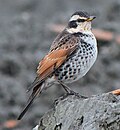 | Dusky thrush | Turdus eunomus | south to south-east Asia, principally in China and neighbouring countries |
 | Naumann's thrush | Turdus naumanni | South Asia to Southeast Asia |
 | Chestnut thrush | Turdus rubrocanus | western Himalayas and central to south-western China; it winters in Eastern Himalaya and northern Southeast Asia |
 | White-collared blackbird | Turdus albocinctus | Bangladesh, Bhutan, India, Myanmar, Nepal and Pakistan |
 | Sulawesi thrush | Turdus turdoides | Sulawesi Island in Indonesia |
 | American robin | Turdus migratorius | North America, from Alaska and Canada southward to northern Florida and Mexico |
 | Black thrush | Turdus infuscatus | El Salvador, Guatemala, Honduras, and Mexico |
 | Rufous-collared thrush | Turdus rufitorques | Central America, south of the Isthmus of Tehuantepec, occurring in El Salvador, Guatemala, Honduras, and Chiapas state in Mexico |
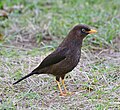 | Sooty thrush | Turdus nigrescens | Costa Rica and western Panama |
 | Western red-legged thrush | Turdus plumbeus | The Bahamas, Cayman Brac, Cuba |
 | Eastern red-legged thrush | Turdus ardosiaceus | Dominica, Hispaniola (Dominican Republic and Haiti), Puerto Rico |
| Grand Cayman thrush | †Turdus ravidus | Grand Cayman (extinct since 1938) |
 | White-chinned thrush | Turdus aurantius | Jamaica |
 | Forest thrush | Turdus lherminieri | Dominica, Guadeloupe, Montserrat, and Saint Lucia |
 | Mountain thrush | Turdus plebejus | southern Mexico to western Panama |
 | Pale-eyed thrush | Turdus leucops | Bolivia, Brazil, Colombia, Ecuador, Guyana, Peru, and Venezuela |
 | White-eyed thrush | Turdus jamaicensis | Jamaica |
 | La Selle thrush | Turdus swalesi | Hispaniola (Dominican Republic and Haiti) |
 | Chestnut-bellied thrush | Turdus fulviventris | western Venezuela, western Colombia, Ecuador, northern Peru and north-western Bolivia |
 | Plumbeous-backed thrush | Turdus reevei | Ecuador and Peru |
 | Chiguanco thrush | Turdus chiguanco | Ecuador and the Altiplano |
 | Andean slaty thrush | Turdus nigriceps | north-west Argentina, Bolivia, Ecuador and Peru |
 | Glossy-black thrush | Turdus serranus | northern Venezuela to north-western Argentina |
 | Black-hooded thrush | Turdus olivater | Venezuela and Colombia |
 | Great thrush | Turdus fuscater | Andes in western and northern Venezuela as far as Lara and Trujillo, the Andes of Colombia, Ecuador, Peru, and finally, northwest Bolivia |
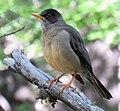 | Austral thrush | Turdus falcklandii | south Argentina and south and central Chile |
 | Lawrence's thrush | Turdus lawrencii | Bolivia, Brazil, Colombia, Ecuador, Peru, and Venezuela |
| Pantepui thrush | Turdus murinus | foothills of south Venezuela and Guyana |
 | Blacksmith thrush | Turdus subalaris | north-east Argentina, eastern Paraguay and southern Brazil |
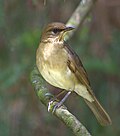 | Creamy-bellied thrush | Turdus amaurochalinus | central and eastern South America |
 | Tristan thrush | Turdus eremita | British overseas territories of the isolated Tristan da Cunha archipelago |
 | Marañón thrush | Turdus maranonicus | southern Ecuador and northern Peru |
 | Black-billed thrush | Turdus ignobilis | western Amazonia and on the Guianan Shield, occurring in Bolivia, Brazil, Colombia, Ecuador, Peru, Venezuela, and Bolivia |
 | Campina thrush | Turdus arthuri | lowlands of south-eastern Venezuela, Guyana and Suriname, east Colombia and west-central Amazonian Brazil |
 | Yellow-legged thrush | Turdus flavipes | northern Colombia, Venezuela, far northern Brazil, Trinidad, and Tobago, as well as parts of the Pakaraima Mountains in western Guyana, eastern Brazil, eastern Paraguay, and far northeastern Argentina |
 | White-throated thrush | Turdus assimilis | Central America |
| Dagua thrush | Turdus daguae | Panama to north-western Ecuador |
 | White-necked thrush | Turdus albicollis | eastern Brazil, far northern Uruguay, eastern Paraguay and far north-eastern Argentina |
 | Rufous-backed thrush | Turdus rufopalliatus | south-eastern Sonora to the south-eastern corner of Oaxaca along the coast and in the Río Balsas drainage, with isolated populations in Mexico City and Oaxaca City |
 | Pale-vented thrush | Turdus obsoletus | Colombia, Costa Rica, Ecuador, Panama, and Peru |
 | Pale-breasted thrush | Turdus leucomelas | eastern and northern South America |
 | Cocoa thrush | Turdus fumigatus | South America |
 | Hauxwell's thrush | Turdus hauxwelli | Bolivia, Brazil, Colombia, Ecuador, Peru, and Venezuela |
 | Rufous-bellied thrush | Turdus rufiventris | southeast Brazil from Maranhão south to Rio Grande do Sul states, Bolivia, Paraguay, Uruguay and northern regions of Argentina |
 | Clay-colored thrush | Turdus grayi | South Texas (where it is rapidly expanding its range) to northern Colombia |
 | Spectacled thrush | Turdus nudigenis | South America from Colombia and Venezuela south and east to northern Brazil, and in Trinidad and Tobago |
 | Ecuadorian thrush | Turdus maculirostris | western Ecuador and far north-western Peru |
 | Várzea thrush | Turdus sanchezorum | western Amazon |
| Unicolored thrush | Turdus haplochrous | Bolivia |























































































